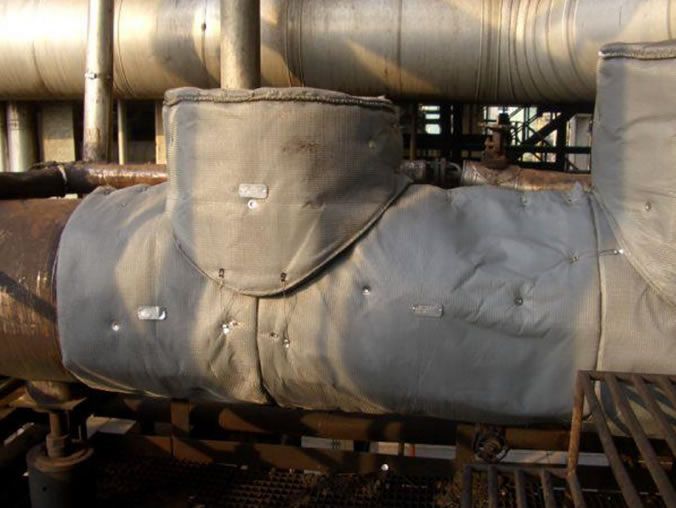HIGH TEMPERATURE NON-WICKING PROCESS BLANKET
HT1100MTFM (HT593C-MTFM)
INTRODUCTION
Shannon Thermal Blankets are a CAD designed, CNC produced, high-quality pre-engineered insulation system designed to reduce radiant heat loss, minimize insulation maintenance and improve the surrounding work environment. Shannon Thermal Blankets are weather and chemical resistant. Shannon Thermal Blankets are a self-contained, non-wicking insulation system, with integral fasteners. Shannon Thermal Blankets are flexible, easy to install, remove and reinstall, allowing quick and easy access for serviceability. The key benefit is re-usability.
Common Applications and Markets:
Shannon Thermal Blanket Applications include: Valves (Gate, Globe, BFV, Control), Strainers, Flanges (Pipe, Vessel), Pump Housings, Flow Meters, Expansion Joints, Heat Exchangers, Manways, Equipment Heads. Markets: Oil & Gas Industry, Refineries, Chemical, Petrochemical.
Service Temperature
This design is a Non-Porous, Non-Wicking Thermal Insulation Barrier with a service temperature to 1100˚F (593˚C).
Product Components
The Outer Jacketing consists of a layer of Stainless Steel Type 304 Knitted Wire Mesh .011” Dia. @ 16ft²/LB (0.28 mm Dia. @ 3.3 m²/KG) and a layer an Outer Jacketing of 16.5oz/yd² (560g/m²) PTFE Teflon® Impregnated Fiberglass Cloth. The inner jacketing consists of a layer of Stainless Steel Type 304 Sheet Foil .002” thickness and a layer of Stainless Steel Knitted Wire Mesh. The Insulation Core Material is a 176.2 kg/m3 (11 lb/CF) Fiberglass Needled Mat-Type E Fiber. The Fiberglass Mat is encapsulated by the inner and outer layers of jacketing, then stapled together, producing a Self Contained Blanket System. The Blanket System includes an Integral Fastener for install & removal.

Petro Chemical Valves & Fittings
BLANKET THICKNESS SURFACE TEMPERATURE REFERENCE
Operating Temp |
Thickness |
Surface Temp |
Thickness |
Surface Temp |
Thickness |
Surface Temp |
|---|---|---|---|---|---|---|
| 371˚ C (700˚ F) | 40 mm (1.5″) | 69.2˚ C (156.5˚ F) | 50 mm (2″) | 59.8˚ C (139.6˚ F) | 65 mm (2.5″) | 53.6˚ C (128.4˚ F) |
| 427˚ C (800˚ F) | 40 mm (1.5″) | 79.2˚ C (174.6˚ F) | 50 mm (2″) | 68.1˚ C (154.5˚ F) | 65 mm (2.5″) | 60.7˚ C (141.2˚ F) |
| 482˚ C (900˚ F) | 40 mm (1.5″) | 90.3˚ C (194.5˚ F ) | 50 mm (2″) | 77.2˚ C (171.0˚ F ) | 65 mm (2.5″) | 68.6˚ C (155.4˚ F ) |
| 538˚ C (1000˚ F) | 50 mm (2″) | 87.4˚ C (189.4˚ F) | 65 mm (2.5″) | 77.3˚ C (171.2˚ F) | 80 mm (3″) | 70.1˚ C (158.1˚ F) |
| 593˚ C (1100˚ F) | 50 mm (2″) | 98.7˚ C (209.7˚ F) | 65 mm (2.5″) | 87.1˚ C (188.8˚ F) | 80 mm (3″) | 78.7˚ C (173.7˚ F) |
* The above referenced Cold Face Surface Temperatures should be used as guidelines for blanket insulation thickness design.
* The Cold Face Surface Temperature of the blanket should approach surrounding ambient temperature conditions.
* The economic thickness of the blanket should consider blanket cost, thermal performance and blanket design constraints.
* Heat loss calculations are based on a 21.1˚ C (70˚ F) ambient temperature using a flat surface condition.
